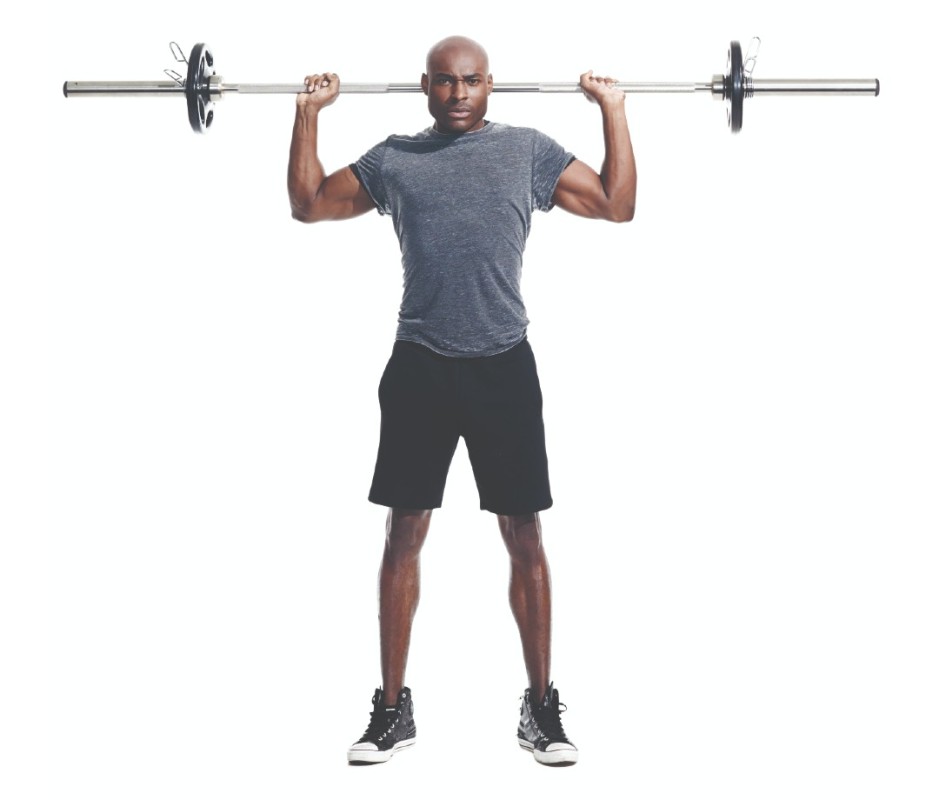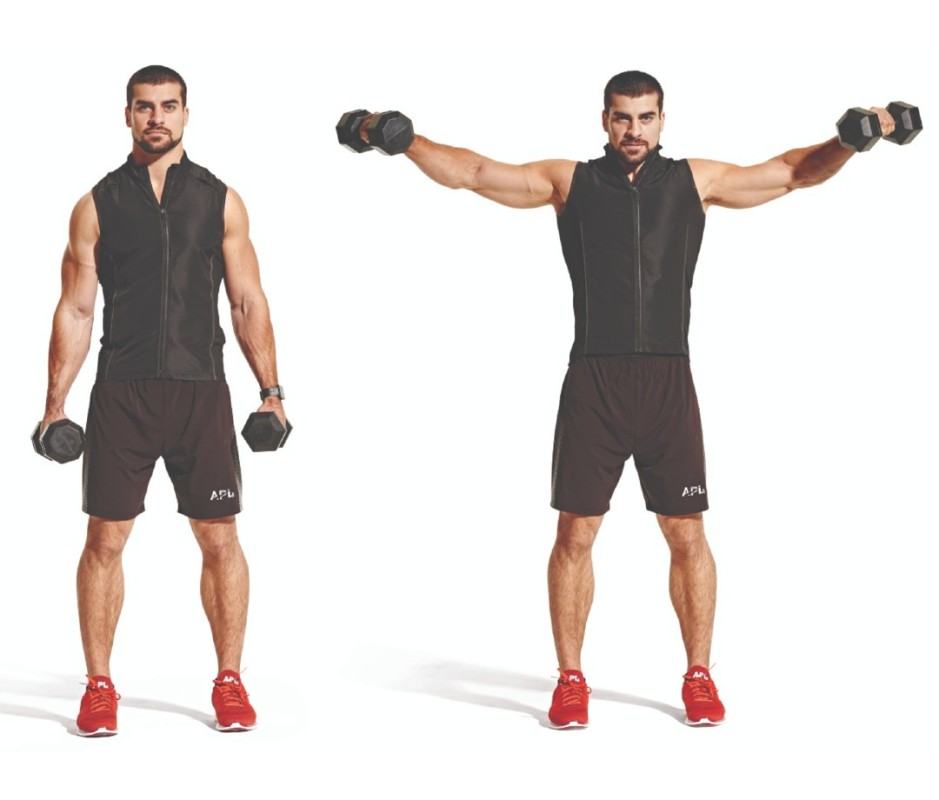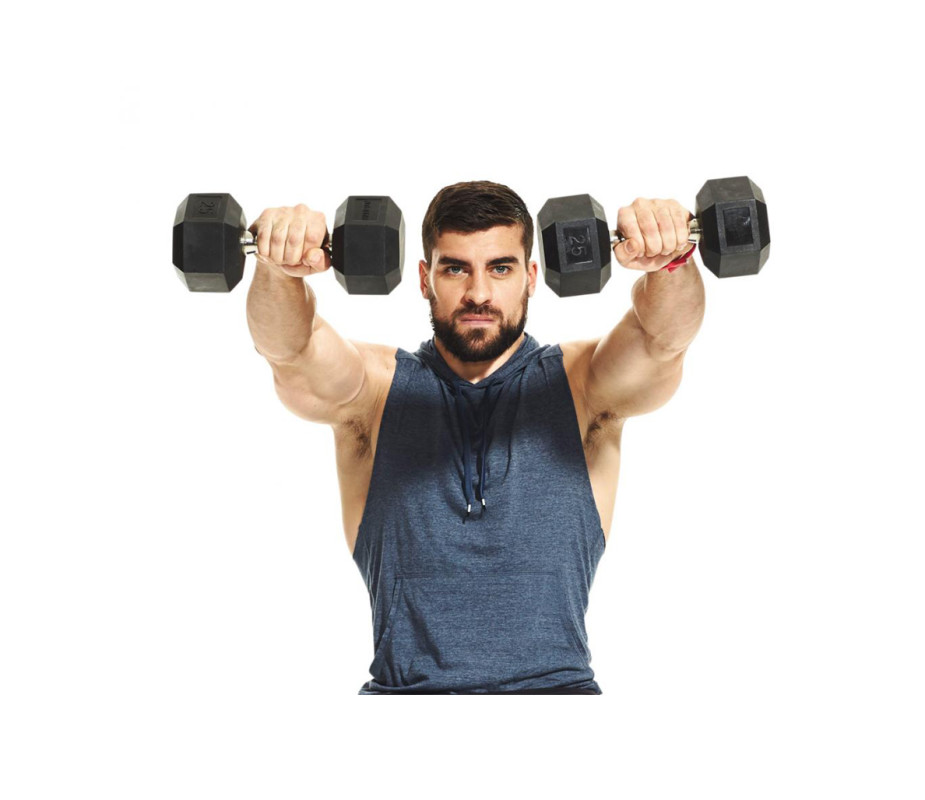10 Best Ways to Bulk and Broaden Your Upper Body to Craft the Coveted V-Taper
Build a wide, round set of shoulders and a more imposing upper body overall.

If there’s one body part that adds an instant air of dominance and masculinity to a man’s physique, it’s the shoulders. They cap off a fit waist, make your frame look proportional, and craft the coveted V-taper. If you’re not training your entire upper body in favor of blasting your biceps or triceps, you’re missing out.
A strong set of shoulders will make your life easier. Everyday movements like playing sports and lifting suitcases will be more of a breeze, plus you'll reduce your risk for injury during back and chest exercises and make your workouts less stressful—on your mind and muscles.
We spoke with Noah Bryant, C.S.C.S., for the 10 best exercises to thicken and widen your shoulders to create a V-taper body.
"To successfully grow a pair of behemoth shoulders, you need to be aware that the deltoid is made up of three heads, the anterior deltoid (front), the lateral deltoid (side), and the posterior deltoid (rear)," Bryant says. "For symmetrical growth, you always want to start your training with the big, compound movements, then hit all three heads with lighter isolation movements."
Check out Bryant's V-taper exercise picks below.
How to Build a V-Taper: Best Workout to Bulk and Broaden
Directions
Pick 2 to 3 compound movements and 3 to 4 isolation moves on shoulder day to hone capped shoulders, bulked traps, and a broader upper body that'll show through even your chunkiest winter sweaters.
1. Overhead Press (Compound)

Beth Bischoff
"This is one of the best overall delt-developing exercises," Bryant says. While most guys think of the bench press as the ultimate upper-body exercise, the overhead press truly is a tremendous muscle-builder. If you have a healthy back and shoulders, you don't make any rookie mistakes, and you execute it with proper form, you're practically guaranteed to fill out your frame. You also get the added benefit of working your triceps.
How to Do It
- Grasp the bar with a narrow grip slightly wider than shoulder-width.
- Keep your elbows vertical and your feet slightly wider than shoulder-width.
- With the bar on your anterior delts, tighten your legs, glutes, back, and abs, then press upward.
- Move your head slightly out of the way as the bar rises, returning it to its natural position once it clears your head.
- Fully extend your elbows above the crown of your head and shrug your shoulders to engage your traps. Avoid doing a push press; keep your knees straight to focus on your delts rather than using your legs.
- Do 3-5 sets of 5-8 reps
Pro Tip
You might have to go lower in weight than you're used to in order to get the form right because this works smaller, lesser-used muscles in your upper body.
2A. Behind-the-Neck Press (Isolation)

James Michelfelder & Therese Sommerseth
This is another full-shoulder exercise that can cause injury when executed improperly. But when it's done right, the behind-the-neck press effectively works the entire musculature of your shoulders, Bryant says.
- Grip the bar with hands a couple inches wider than shoulder-width.
- Press the bar overhead without locking your elbows.
- Lower it behind your head, keeping your neck slightly flexed.
- Press the bar back up before it touches your traps or if you feel discomfort.
- Do 3-5 sets of 6-10 reps.
Pro Tip
You can perform this either seated with back support, or standing.
2B. Alternating Dumbbell Press (Compound)

James Michelfelder
"Doing this exercise unilaterally (one arm at a time) maximizes time under tension and helps to identify and eliminate imbalances," Bryant says.
How to Do It
- Start with both dumbbells in the locked-out position above your head, palms facing out/forward.
- Slowly lower one arm at a time, then press the dumbbell back up.
- Keep your non-moving hand locked out above your head (until the hand in motion returns to the top), or keep it stationary on your lap.
- Repeat this process using your other arm.
- Do 4 sets of 6-8 reps on each arm.
Pro Tip
You can perform this exercise standing or seated.
3. Barbell Upright Row (Compound)

James Michelfelder & Therese Sommerseth
"Barbell upright rows will hit your front and side deltoids, and it'll tie in the traps," Bryant says. Again, take care to execute with proper form.
How to Do It
- Grasp the bar just narrower than shoulder-width apart with an overhand grip.
- Leading with your elbows, pull the bar straight up toward your chin, keeping your elbows high and the bar close to your body.
- Lower the bar back down and repeat.
- Do 4 sets of 8-15 reps.
4. Barbell Front Raise (Isolation)

James Michelfelder
You're targeting your front delts, but you'll feel the fatigue setting into your side delts as well. Bryant advises: "Keep the weight light enough to perform the lift with good technique." Note: You can also use dumbbells or exercise bands if you're working out at home.
How to Do It
- While standing, grip a barbell with hands shoulder-width apart and palms facing down.
- Stand up straight with the bar hanging against your thighs. Pull your shoulder blades back and engage your core, positioning the bar about 5" from your body.
- Lift the bar in an arc motion to shoulder height, keeping arms straight, and avoid swinging.
- Pause, then lower the bar back to the starting position.
- Do 4-5 sets of 12-20 reps.
5. Incline Lateral Raise (Isolation)

James Michelfelder
"This is a great isolation movement for your side delts," Bryant says. "Make sure to emphasize the stretch at the bottom of the lift and keep the reps controlled."
How to Do It
- Grab a pair of dumbbells and sit on an incline bench with your arms straight down at your sides.
- Raise the dumbbells straight out (so your arms are parallel to the floor) until you reach shoulder level.
- Lower your arms, keeping control of the dumbbells the whole time.
- Do 3-5 sets of 12-15 reps.
6. Face Pull (Compound)

Beth Bischoff
"Face pulls work the posterior deltoid and, surprisingly to most, even put extreme stress on the medial deltoid," Bryant says. "Pulls also target your back’s weak scapular muscles, which aid in stabilization of your shoulder joints—great for shoulder health."
How to Do It
- Use the rope attachment on the highest pulley of a cable weight machine.
- Start with the rope a couple inches above your eyes.
- Grab the rope with an overhand grip, and take a step back so there’s tension in the rope.
- Sit your hips back, and begin pulling the cable. Let your elbows flare out so they’re parallel to the ground.
- Pull the rope toward your eyebrow, then return it—under control—to the starting position.
- Do 3-5 sets of 15-20 reps.
7. Bentover Lateral Raise (Isolation)

James Michelfelder
"The bentover lateral raise directly targets your posterior delt (the back of the shoulders)," Bryant says. The key here is to keep the movement strict to really get the benefit of the exercise.
- Bend over until your torso is parallel to the ground, holding dumbbells with palms facing each other.
- Keep your lower back naturally arched. Squeeze your shoulder blades to lift the weights in an arc until they're parallel to the floor, with thumbs pointing up.
- Return to the starting position.
- Do 3-5 sets of 8-12 reps.
8. Incline I,Y,T’s (Compound)

James Michelfelder
Unlike some of the other moves, which have an emphasis on bulking your upper body, this movement really hones in on shoulder health, Bryant says. Though it'll give you the aesthetic you're looking for, too.
- Lie chest-down on a 45° incline bench, holding a dumbbell in each hand with arms hanging down (toes touching the ground).
- Squeeze shoulder blades and raise dumbbells to your sides (making a “T”), then lower.
- Raise them to head-level (making a “Y”), then lower.
- Raise them straight in front (making an “I”). This completes 1 rep.
- Do 4 sets of 5-8 reps.
Pro Tip
Keep the weight very light for this exercise—it'll sneak up on you.
9. Standing Lateral Raise (Isolation)

James Michelfelder
Do this as a combination of two exercises. First, you'll do a set of lateral raises, then immediately go into a set of front raises (following exercise) to complete the superset.
- Stand with your knees slightly bent, leaning forward with a dumbbell in either hand.
- Raise your upper arms out to your sides until your elbows (which should be slightly bent) are shoulder-height.
- Return to the start position.
Pro Tip
Don’t use a weight that’s too heavy and avoid using momentum to complete the motion.
10. Front Raise (Isolation)

James Michelfelder
Front raise exercises really work flexion by isolating your anterior (front) deltoid.
- While standing with your feet hip-width apart, hold a dumbbell in each hand, palms-down, about 5" in front of your thighs.
- Raise your arms in front of you, keeping a slight bend in your elbows.
- Pause when the dumbbells reach shoulder height, then slowly bring them back to the starting position.
- Do 3-5 sets of 10 reps of each exercise (for a total of 20 reps per set).
Pro Tip
Don’t use momentum or lower the dumbbells too quickly. You want to keep the motion controlled to get a good contraction in your shoulder in order to improve stability through the joint.
Related: The Most Creative Dumbbell Workouts to Build Muscle and Burn Fat at Home






























.png)





















![‘Companion’ Ending Breakdown: Director Drew Hancock Tells All About the Film’s Showdown and Potential Sequel: ‘That’s the Future I Want for [Spoiler]’](https://variety.com/wp-content/uploads/2025/02/MCDCOMP_WB028.jpg?#)
























